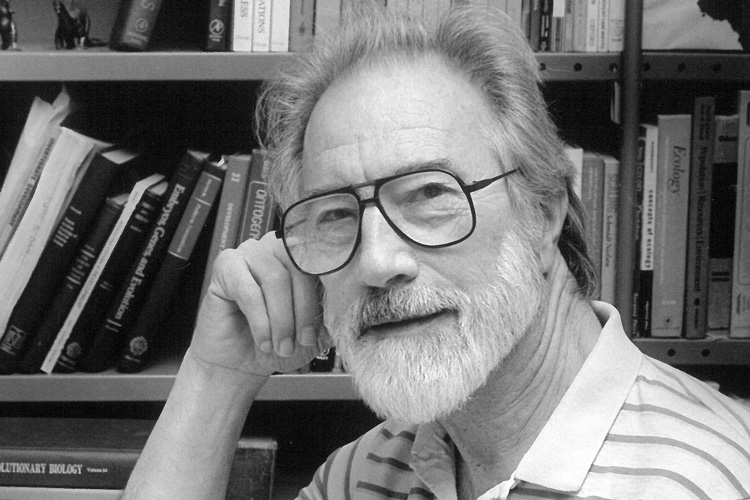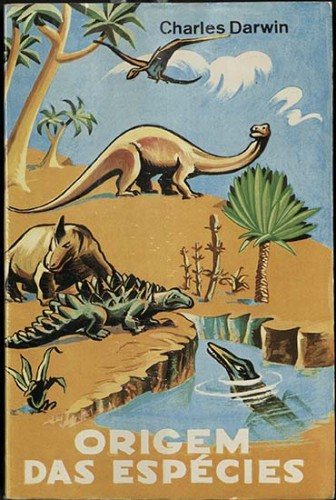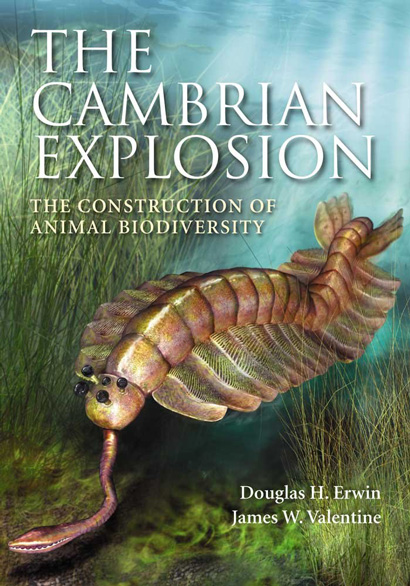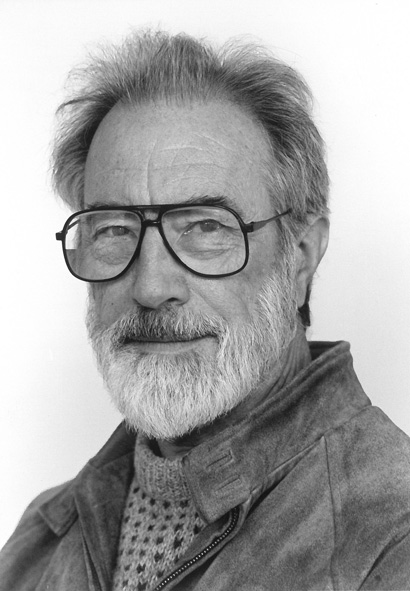
James Valentine, a UC Berkeley professor emeritus of integrative biology and a pioneer of modern paleobiology. (Photo by Peg Skorpinski, 1991)
James W. Valentine, a pioneering paleontologist who drew upon ecology, geology, developmental biology and genetics to understand the evolution of complex animal life on Earth, died April 7, 2023, of natural causes in a care facility near his home in Albany, California. He was 96.
Valentine was an emeritus professor of integrative biology at the University of California, Berkeley, and an emeritus curator at the UC Museum of Paleontology (UCMP).
He is best known for championing an ecological approach to understanding the evolution of animal diversity from its inception some 700 million years ago to the present. According to one of his former graduate students, Douglas Erwin, Valentine viewed fossils in a new way: as creatures living in a community, which means it's necessary to consider the ecology of ancient seas - what other animals were around and which animals were predators and which prey - in order to understand evolution.
"Valentine was, with Dave Raup at Chicago, one of the founders of modern paleobiology," said Erwin, a curator at the Smithsonian Institution's National Museum of Natural History and one of Valentine's graduate students when Valentine was on the faculty at UC Santa Barbara. "While Dave was very analytical and quantitative, Jim was more ecological and intuitive in his thinking. Dave and Jim were sort of a generation ahead of Steve Gould, Jack Sepkoski and others, who then enlarged on what they did."
Stephen Jay Gould was a well-known Harvard University paleontologist, evolutionary biologist and historian of science who published widely before his death in 2002. J. John Sepkoski, who died in 1999, was at the University of Chicago with Raup and was known for creating and analyzing global compendia of marine animal families and genera, the most up-to-date compilations of our knowledge of the entire fossil record at the time.
In a 1996 festschrift in honor of Valentine, the late Gould wrote, "We who had the great privilege to participate in the excitement of forging a new explanatory discipline within evolutionary theory - paleobiology, with emphasis on the non-extrapolatable causes of geological scales - owe an enormous debt to Jim Valentine for being there first in a truly uncharted territory."
In pushing the bounds of the then-current understanding of how ecology works in the modern world and in the deep past, Valentine shaped the way scientists now view major patterns in the history of life.
"I had grown up looking at the exhibits at the American Museum of Natural History, which of course were dominated by dinosaurs and other gigantic vertebrates," said paleontologist David Jablonski, a professor of geophysical sciences at the University of Chicago and a frequent collaborator and former postdoctoral fellow with Valentine at Santa Barbara. "The way people studied those was more about the evolutionary unfolding of individual lineages. Jim asked bigger questions, about how the biosphere evolved, the interaction of major groups and how these groups respond to the physical environment, including the formation of supercontinents and the fragmentation of supercontinents with continental drift and plate tectonics. This was really cutting edge at the time."
Plate tectonics
Valentine was among the first to realize that plate tectonics - a theory, proposed in the 1960s, that Earth's crust is divided into plates, like puzzle pieces, that shift over time - provided one way for diversity to take off, by separating populations from one another and allowing them to evolve independently.
"He was the one who really realized that biodiversity might be pumped to higher levels if you break the continents apart and allow each one to become its own biological laboratory," Jablonski said.
"Jim was always right at the intellectual forefront as new discoveries were made," said Charles Marshall, UC Berkeley professor of integrative biology and director of the UCMP. "Continental drift and plate tectonics, or developmental genetics and genomics - he's always been right there asking, 'What do these new breakthroughs tell us about the history of life and how evolution happens on geologic time scales?' He was repeatedly at the pioneering cutting edge."
Erwin noted, "Jim touched an incredible breadth of topics across the history of life."
One of Valentine's innovative approaches was to measure time's arrow in the evolutionary process by scouring the literature to document the increasing number of cell types as time unfolded.
"A lot of what he did, nobody ever thought of doing before. And that [the number of cell types] was certainly one of them," Erwin said. "He was combining intuition from modern biology to understand the past."
Jablonski said that Valentine's 1973 book, Evolutionary Paleoecology of the Marine Biosphere, had a huge influence not only on his career, but on the entire field of paleontology and developmental biology. Many of Valentine's predictions about evolution, which he based on a much sparser knowledge of the fossil record than we have today, turned out to be correct.
"Jim would sometimes intuit the answer to a problem and then work backwards to gather the evidence to see if his intuition was correct. And it almost always was, because his intuition was incredible," Erwin said.
According to Marshall, Valentine and Raup both realized that even though the fossil record is incomplete, the fossils we have today can tell us a lot about ecosystems in the past, much the way that a poll can reveal the opinions of an entire population.
"Jim helped found the journal Paleobiology, which started to publish papers on large-scale patterns and processes in the fossil record, extending the intellectual reach of the discipline beyond the descriptions of new fossil species and higher taxa," said Marshall, who co-authored several papers with Valentine.

One of the books in Valentine's collection, which was donated to the American Philosophical Society, was a 1979 Portuguese edition of Charles Darwin's historic book, On the Origin of Species.
"It's difficult to imagine the current, vibrant, multidisciplinary state of paleobiology without Jim Valentine and his pioneering work," Jablonski said. "Virtually every one of the really big questions we ask now has at least some encounter with some of the work that Jim has done involving biological diversity, its formation and its maintenance and spatial dynamics. He worked with this amazing ability to synthesize ideas from different fields and bring them to bear on some of the really big questions in large-scale evolution."
Valentine also was a huge fan of Charles Darwin, the main originator of the theory of evolution. He accumulated one of the largest collections of translations and editions of Darwin's writings, including first editions of nearly all of Darwin's 19 books and 23 translations of his seminal book, On the Origin of Species. In 2007, Valentine donated his collection of approximately 4,500 volumes to the American Philosophical Society in Philadelphia, the oldest learned society in the United States.
Valentine titled his 2004 book about the evolution of the major animal groups, the phyla, On the Origin of Phyla, "in homage to the greatest biologist who has ever lived," Valentine wrote in the preface.
War saved him from L.A. gangs
James William Valentine was born on Nov. 10, 1926, in South Los Angeles and raised by a single mother who taught piano. He always told people that he was saved from joining a neighborhood gang by the outbreak of World War II. He joined the U.S. Navy in 1944 and served as quartermaster of a troop carrier, ferrying soldiers to battles to retake islands in the Pacific Ocean that had fallen to the Japanese.
After his return in 1945, he followed a close friend into college at the now-defunct Phillips University in Enid, Oklahoma, taking advantage of the GI Bill. He developed an interest in geology, and after graduating in 1951, he entered graduate school at UCLA. While working summers as an oil geologist, he researched and wrote his Ph.D. thesis on the marine mollusk fossils along the coasts of Southern California and Baja California, working under paleontologists Daniel Axelrod and Ulysses S. Grant IV - the grandson of the famous Civil War general. Valentine earned an M.A. in 1954 and Ph.D. in 1958, both in paleontology.
His Ph.D. thesis was one of the last times he conducted fieldwork. The remainder of his career was mostly theoretical, as he mined the paleontology literature and museum collections to understand the origin of animal diversity.
"One of his strengths was the ability to delve into very large and complex literatures, synthesizing them in authoritative books," Marshall said.
Valentine joined the faculty at the University of Missouri, Columbia, in 1958; left for UC Davis in 1964; relocated to UC Santa Barbara in 1977; and eventually settled at UC Berkeley in 1986. He retired in 1993, but continued publishing until the coronavirus pandemic in 2020.
He always said that he got his best ideas from interacting with students and colleagues. Upon being awarded the Paleontology Society Medal in 1996, Valentine responded: " … for constantly sending me back to the books, back to school, so to speak, to try to understand new developments and new approaches, it's appropriate to dedicate this award to my grad students and postdocs, mentors, indeed. And thank you all."
One of those graduate students was Erwin, with whom Valentine wrote The Cambrian Explosion: The Construction of Animal Biodiversity in 2013. Before about 550 million years ago, most species on Earth lived in the oceans and consisted primarily of single-celled organisms and the very earliest multicellular animals, such as sponges and jellyfish. Then, over a period of some 20 million years, animal diversity exploded around the world. Beginning in the 1960s, Valentine and Raup tried to answer a profound question: Why did animal diversity take off in the Cambrian, and how did that lead to the great diversity of animal life today? Valentine then teamed up with Erwin to explore the topic in much greater detail in their 2013 book.
"Erwin and Valentine have provided a much needed, authoritative account of what we know and, just as importantly, what we don't yet know about the geology, ecology and biology of the 'Big Bang' of animal evolution," geneticist Sean Carroll, now a professor emeritus at the University of Wisconsin, wrote at the time.
Over the course of his career, Valentine authored, co-authored and edited six books and more than 200 articles in the fields of evolutionary ecology and paleoecology. In the end, Erwin said, Valentine was unable to completely explain the origin of complex animals during the Cambrian Explosion. These are questions, Erwin said, that remain for future paleontologists.
"I don't think we've completely solved that problem," Erwin said. "I think that, in some ways, it's such a great event in Earth's history that it would be a shame to figure everything out."
Valentine had enormous stature within the discipline, Marshall said, despite the fact that he was "remarkably shy and self-effacing."
Valentine's former wife, Cathryn Campbell, called him "private" and "humble." Yet, he was firm in his arguments, even in the face of criticism in the 1960s from more traditional paleontologists, who tended to focus on the evolutionary trajectory of specific marine organisms rather than the evolution of ecosystems consisting of many interacting organisms.
Over the course of his career, Valentine was named a fellow of the National Academy of Sciences, American Philosophical Society and American Academy of Arts and Sciences, received the Lapworth Medal of the U.K.'s Palaeontological Association and the Paleontological Society Medal, was a Guggenheim Fellow at both Yale University and Oxford University, and was named a Fulbright Research Scholar to study in Australia. He served as president of the Paleontological Society from 1974 until 1975.
Valentine was married and divorced three times: first to Grace Whysner, with whom he had two children, Anita Grace Lawrence and Ian James Valentine of Madison, Wisconsin; Cathryn Campbell of Washington state, with whom he had a son, Geoffrey Darwin Campbell Valentine, who died in 2017; and the late Diane Mondragon. He is survived by four grandchildren and two great-grandchildren by his daughter, Anita.








